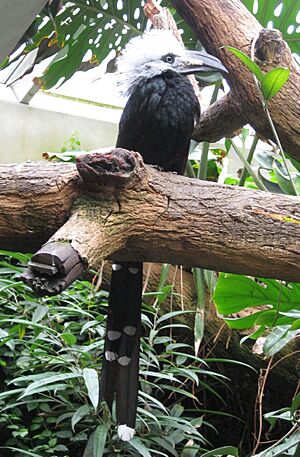Western long-tailed hornbill facts for kids
The western long-tailed hornbill (Horizocerus albocristatus) is a unique bird that lives in the wet forests of West Africa. It's a type of hornbill, known for its long tail and a special crest on its head. This bird was once called the "white-crested hornbill" and was thought to be the same as the eastern long-tailed hornbill.
Quick facts for kids Western long-tailed hornbill |
|
|---|---|
 |
|
| T. a. albocristatus at Central Park Zoo, USA | |
| Conservation status | |
| Scientific classification | |
| Genus: |
Horizocerus
|
| Species: |
albocristatus
|
| Synonyms | |
|
Buceros albocristatus (protonym) Tockus albocristatus |
|
Contents
How Scientists Name It
Scientists give every living thing a special two-part name, like a first and last name. This helps everyone around the world know exactly which animal they are talking about.
Its Official Name
The western long-tailed hornbill got its official name in 1848. An American bird expert named John Cassin described it. He found a bird near the Saint Paul River in Liberia. He named it Buceros albocristatus.
The name albocristatus comes from two Latin words:
- albus means "white"
- cristatus means "crested" or "plumed"
So, its name means "white-crested hornbill." Later, scientists moved this bird into a different group, or genus, called Horizocerus.
Different Types of Western Long-tailed Hornbills
There are two slightly different types, or subspecies, of the western long-tailed hornbill. They mostly look different in how much white they have on their head and neck. Also, some have white tips on their wing feathers.
- H. a. albocristatus: This type lives from Guinea to the western part of Ivory Coast.
- H. a. macrourus: This type lives from the eastern part of Ivory Coast all the way to Benin.
Where It Lives
The western long-tailed hornbill lives in a big area of West Africa. You can find it in countries like:
- Southern Sierra Leone
- Côte d'Ivoire
- Ghana
- Guinea
- Liberia
- Togo
- Benin
It likes to live in humid forests. This bird is quite common in many places where it lives. Even though it's hard to count exactly how many there are, scientists don't think it's in danger of disappearing.
Images for kids





